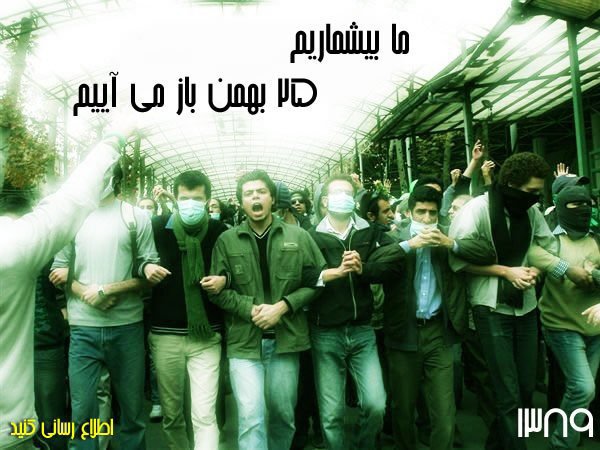Iran Analysis: Can the Opposition Challenge the Regime? (Eshraghi v. Lucas)
 On Friday, Ali Reza Eshraghi, writing for Asia Times Online, posted a provocative analysis of recent opposition moves. While he notes the public re-emergence of the challenge to the regime, notably through the marches of 14 and 20 February, Eshraghi argues, "The Green movement has not yet created all the preconditions for becoming a dominant force."
On Friday, Ali Reza Eshraghi, writing for Asia Times Online, posted a provocative analysis of recent opposition moves. While he notes the public re-emergence of the challenge to the regime, notably through the marches of 14 and 20 February, Eshraghi argues, "The Green movement has not yet created all the preconditions for becoming a dominant force."
I post a response, followed by Eshraghi's article:
Lucas: An Artificial View of the "Green Movement" and Opposition
Esraghi makes some rich points, especially about the debate within the opposition over aims --- James Miller brought this out in an analysis for EA last week. And Eshraghi is also on the mark about difficulties of co-ordination of the challenge.
The article is marked by significant errors, however. Eshraghi's dramatic declaration that the opposition is "losing some erstwhile friends in the Iranian establishment" is a red herring; he only cites two examples --- a Mashhad ayatollah and former Presidential candidate Ali Akbar Nategh Nouri --- and neither of those men had allied themselves with the post-election opposition.
More important are the flaws in an over-wrought analysis. Eshraghi sets up an artificial standard, probably in light of the excitement over developments in the Arab world, of “Revolution”. There has never been a unified line amongst the opposition for that, and none of the activists in Iran were predicting the imminent demise of the Islamic Republic. The phrase “marathon, not a sprint” has been the dominant one.
His framing of the “Green Movement” is also artificial. We are well past the period just after the 2009 election when Green could cover the specific protests against the vote. There are wider civil rights issues beyond that, which means there are a range of groups in play for the opposition. The phrase “Green” might be used from time to time, but Mousavi’s Green Path is an obsolete notion — look at the approach of the statement in the names of Mousavi and Karroubi this week.
This is far more than what Eshraghi pictures as a north Tehran movement. The shrewder people in the opposition know that they have to look to other social movements and economic groups to move forward.
So Eshraghi misunderstands the point of the recent demonstrations, when he writes, "If their main aim is to show the government that they still exist, street protests are reduced to being a kind of carnival, unfortunately featuring police batons and tear gas rather than balloons and refreshments." The public revival through the marches is merely the sign that the opposition is still alive.
The challenge will be to turn that into plans and objectives for change. That is a daunting challenge, but --- contrary to Esraghi's wayward pronouncement, "Opposition activity is confined...to what the regime does" --- it is being pursued
Eshraghi: Revolution not in the cards in Iran
Vladimir Lenin had a formula for diagnosing the symptoms of revolution, "Those at the bottom won't, those at the top can't." He argued that revolution required mass involvement, a spirit of courage and commitment, and political engagement. These three conditions do not yet exist in Iran.
The demonstrators who came to the streets of Tehran on February 14 and in smaller numbers on February 20 certainly had courage. They were ready to face anything despite the violence the regime used against mass protests in 2009. And they voiced the most radical slogan yet heard --- one that was not heard in the 2009 demonstrations - attacking the normally inviolate Supreme Leader Ayatollah Ali Khamenei.
They also showed judgement by knowing when to shout slogans and when to keep quiet, how to flee from danger and how to avoid being identified.
There are significant differences between the two demonstrations. On February 14, the regime did not appear to be planning violent repression. Two deaths were reported, but it is not still clear how they occurred.
One reason why the regime was reluctant to deploy violence may have been that Turkish President Abdullah Gul was visiting Tehran. But on the other hand, the regime clearly had enough confidence in its ability to handle the protests that it did not postpone the visit.
A more important reason for restraint may have been that the regime wanted to assess the current state of the opposition after the latter's absence from the streets for more than a year. According to one member of the Basiji militia, police would wait for substantial numbers to gather in a given place before arriving on the scene.
The second day of protests this month, February 20, saw a much heavier police presence, outnumbering the demonstrators and in clear anticipation of a crackdown. This deterred many people from coming out into the streets, suggesting that the regime can still count on their fear.
Strangely, some opposition activists used methods similar to those employed by the regime - they tried to censor news of the intimidating security presence, even trying to stop the news getting out on media like the BBC Persian service, in the somewhat naive hope that this would get more people onto the streets.
It is not only courage and commitment that is somewhat lacking. Many Iranians still lack the motivation to join in opposition protests; the will for change is just not strong enough.
Revolution becomes a real prospect when only the opposition and the regime's forces are on the streets, and the apathetic stay away.

 Saturday, February 26, 2011 at 7:15
Saturday, February 26, 2011 at 7:15
Reader Comments